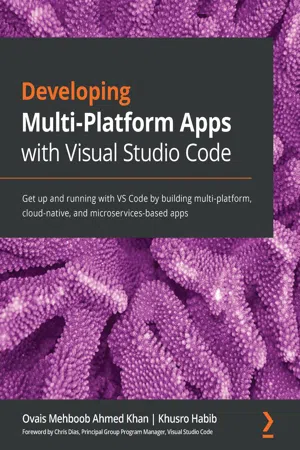
Developing Multi-Platform Apps with Visual Studio Code
Get up and running with VS Code by building multi-platform, cloud-native, and microservices-based apps
- 334 pages
- English
- ePUB (mobile friendly)
- Available on iOS & Android
Developing Multi-Platform Apps with Visual Studio Code
Get up and running with VS Code by building multi-platform, cloud-native, and microservices-based apps
About this book
Redefine your software development experience by understanding the extensive features and rich functionalities offered by Visual Studio Code
Key Features
- Leverage the power of the free, cross-platform, and highly customizable code editor to build modern web and cloud applications
- Edit, debug and deploy on Microsoft Azure with Visual Studio Code
- Learn how to customize features and install a wide variety of third-party extensions
Book Description
Microsoft Visual Studio Code is a powerful, lightweight code editor for modern web and cloud development. It is a source code editor that can be used with a variety of programming languages, which works on multiple platforms such as Linux, Windows, and macOS. This book provides extensive coverage of the tools, functionalities, and extensions available within the VS Code environment that will help you build multi-platform apps with ease.
You'll start with the installation of VS Code and learn about various tools and features that are essential for development. Progressing through the chapters, you'll explore the user interface while understanding tips and tricks for increasing productivity. Next, you'll delve into VS Code extensions and discover how they can make life easier for developers. Later, the book shows you how to develop a sample application with different programming languages, tools, and runtimes to display how VS code can be used effectively for development, before helping you get to grips with source code version management and deployment on Azure with VS Code. Finally, you'll build on your skills by focusing on remote development with VS Code.
By the end of this book, you'll have the knowledge you need to use Visual Studio Code as your primary tool for software development.
What you will learn
- Explore various editing, formatting, and navigational features of VS Code
- Understand how to add, delete, and configure extensions in VS Code
- Develop web APIs using Node.js, Java, and Python in VS Code
- Develop background service in.NET Core and explore Dapr
- Delve into debugging techniques such as breakpoints, log points, and data inspection
- Use Git with Azure DevOps to share and synchronize code with VS Code
- Create custom extensions in VS Code to increase developer productivity
- Understand the concepts of remote development using VS Code
Who this book is for
This book is for software developers, web developers and polyglot programmers, who are working with any language or framework such as Python, Java, Node.js, or.NET and are looking to learn how they can create multi-platform, microservices based, cloud-native applications while effectively using Visual Studio Code for editing, debugging, version management and deployment. Basic software development skills are a must to grasp the concepts covered in this book.
Frequently asked questions
- Essential is ideal for learners and professionals who enjoy exploring a wide range of subjects. Access the Essential Library with 800,000+ trusted titles and best-sellers across business, personal growth, and the humanities. Includes unlimited reading time and Standard Read Aloud voice.
- Complete: Perfect for advanced learners and researchers needing full, unrestricted access. Unlock 1.4M+ books across hundreds of subjects, including academic and specialized titles. The Complete Plan also includes advanced features like Premium Read Aloud and Research Assistant.
Please note we cannot support devices running on iOS 13 and Android 7 or earlier. Learn more about using the app.
Information
Section 1: Introduction to Visual Studio Code
- Chapter 1, Getting Started with Visual Studio Code
- Chapter 2, Extensions in Visual Studio Code
Chapter 1: Getting Started with Visual Studio Code
- Discussing editors and IDEs
- Discussing basic features of VS Code
- Setting up VS Code
- Exploring the VS Code layout
- Editing and code navigation in VS Code
Discussing editors and IDEs
Table of contents
- Developing Multi-Platform Apps with Visual Studio Code
- Why subscribe?
- Preface
- Section 1: Introduction to Visual Studio Code
- Chapter 1: Getting Started with Visual Studio Code
- Chapter 2: Extensions in Visual Studio Code
- Section 2: Developing Microservices-Based Applications in Visual Studio Code
- Chapter 3: Building a Multi-Platform Backend Using Visual Studio Code
- Chapter 4: Building a Service in .NET Core and Exploring Dapr
- Chapter 5: Building a Web-Based Frontend Application with Angular
- Chapter 6: Debugging Techniques
- Chapter 7: Deploying Applications on Azure
- Chapter 8: Git and Azure DevOps
- Section 3: Advanced Topics on Visual Studio Code
- Chapter 9: Creating Custom Extensions in Visual Studio Code
- Chapter 10: Remote Development in Visual Studio Code
- Other Books You May Enjoy